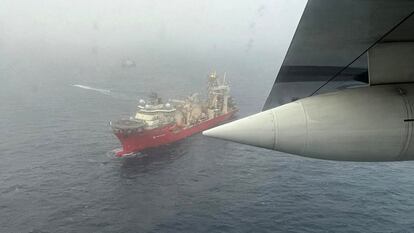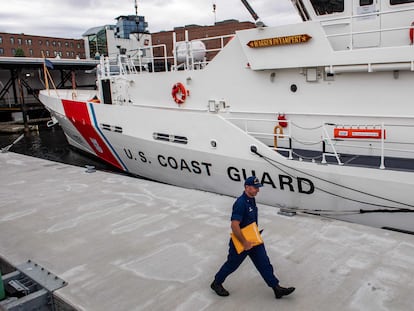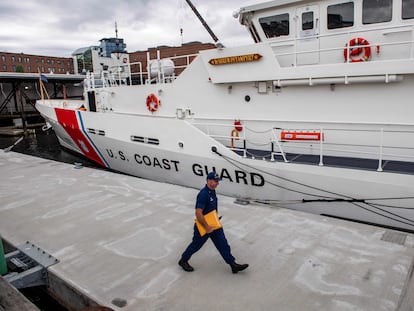Search and rescue efforts to locate ‘Titan’ in the Atlantic reach critical phase
The oxygen supply inside the submersible, which is carrying five passengers, was sufficient for 96 hours, but experts say there are ways to prolong survival expectancy


The race against the clock to rescue the crew of the small submersible that undertook a dive to the wreckage of the Titanic last Sunday in the waters of the North Atlantic has reached a critical point. The estimated survival time for the five occupants of the Titan mini-submarine theoretically expires at 6 a.m. on Thursday morning local time (12 p.m. CEST). The cabin, which is barely 6.5 meters in length, carried enough breathable air to last 96 hours. Rescue efforts were multiplied Wednesday despite the complexity of the operation, which is being carried out in an area of the Atlantic twice the size of Connecticut.
Sounds detected by reconnaissance aircraft on Tuesday and Wednesday, including thumping noises, led to a refocusing and intensification of the search effort, although analysis of those signals was inconclusive, as was the activity of a remotely operated, or remotely controlled, vehicle. The U.S. Coast Guard, which is coordinating the operation from Boston, declined to comment Wednesday on when they might call off the search effort to rescue the five occupants of the mini-submarine — Paul-Henry Nargeolet, a renowned Titanic expert; Hamish Harding, a world-record holding adventurer; Shahzada and Suleman Dawood, two members of one of Pakistan’s wealthiest families, and Stockton Rush, CEO of OceanGate, the company that operates the Titan. “While a search and rescue operation is underway there is hope,” said Coast Guard spokesman Captain Jamie Frederick.
The search for the Titan was concentrated in the area where the sounds were detected. Captain Frederick confirmed that although experts were unable to say with certainty what the noises meant, they were not giving up hope of finding the craft and rescuing its occupants. The search and rescue operation was expanded Wednesday, with the addition of vessels from Canada, the United States, Norway and France, and specialists from the U.S. Navy and the British Royal Navy. In total 10 vessels, supported by three U.S. Army C-130 aircraft, combed an area of 20,000 square kilometers (7,722 square miles), roughly equivalent to the size of El Salvador, to a depth of nearly four kilometers (2.5 miles), while airplanes scanned the area for any visible or invisible traces of the Titan.
OceanGate has faced criticism over the “the current ‘experimental’ approach” of the company” from within the submersible vehicle sector, with 30 representatives warning of problems ranging “from minor to catastrophic” in a letter obtained by The New York Times. The company has flatly rejected the definition of its expeditions as “extreme tourism” for wealthy clients. OceanGate made two trips to the remains of the Titanic in 2021 and 2022, describing the dive an extreme scientific excursion. Passengers are charged around $250,000 per trip.
Weather conditions, which had provided a respite on Tuesday, worsened early Wednesday afternoon through midnight as a storm front passed through the area, adding to the complexity of the rescue operation. According to the U.S. Coast Guard, the search area has been battered by waves of two to three meters high and winds gusting up to 50 kilometers (31 miles) per hour. If the five crew members are still alive - excluding scenarios such as a fire or a flood on board - they are surviving in extreme living conditions: there are no seats in the titanium and carbon fiber cylinder and only a single 21-inch window. Not much more is required for the short planned voyage, which like the two previous expeditions was scheduled to last around 10 hours including the descent, a two-and-a-half-hour exploration around the wreckage of the Titanic at a depth of 4,000 meters, and the ascent back to the surface. If the Titan is located intact, rescuers will face a significant challenge to raise it given the weight of the submersible.
“A very long consent document”
Mike Reiss, a writer and producer who made the trip last year, said that before embarking on the dive passengers must sign a “very long consent document that mentions the possibility of death three times on the first page alone.” David Pogue, a CBS journalist and former technology columnist for The New York Times, who has also traveled on the Titan, described the interior as “the size of a minivan.” The submersible carried sandwiches and water for the voyage. A rudimentary toilet separated by a curtain from the cylindrical cabin where passengers are forced to sit cross-legged, unable to stand or move, completes the ship’s meager facilities. With no radio or GPS, it is piloted with a barely modified video game controller.
Assuming the Titan remains intact, oxygen supply and the period of habitability inside the vessel are not quantifiable values. Several variables could help prolong survival time, according to David Cornfield, a pulmonologist at Stanford University, as quoted in The New York Times. If passengers remain calm and regulate their breathing, they could gain 10% of additional time, or about nine hours, the specialist said. The level of carbon dioxide, an invisible gas exhaled when breathing, also affects survival time. The greater the accumulation of carbon dioxide, the more likely it is that the passengers will become lethargic and lose consciousness. According to some unconfirmed reports, the Titan was equipped with a scrubber, or filter, to expel excess carbon dioxide.
Sign up for our weekly newsletter to get more English-language news coverage from EL PAÍS USA Edition
Tu suscripción se está usando en otro dispositivo
¿Quieres añadir otro usuario a tu suscripción?
Si continúas leyendo en este dispositivo, no se podrá leer en el otro.
FlechaTu suscripción se está usando en otro dispositivo y solo puedes acceder a EL PAÍS desde un dispositivo a la vez.
Si quieres compartir tu cuenta, cambia tu suscripción a la modalidad Premium, así podrás añadir otro usuario. Cada uno accederá con su propia cuenta de email, lo que os permitirá personalizar vuestra experiencia en EL PAÍS.
¿Tienes una suscripción de empresa? Accede aquí para contratar más cuentas.
En el caso de no saber quién está usando tu cuenta, te recomendamos cambiar tu contraseña aquí.
Si decides continuar compartiendo tu cuenta, este mensaje se mostrará en tu dispositivo y en el de la otra persona que está usando tu cuenta de forma indefinida, afectando a tu experiencia de lectura. Puedes consultar aquí los términos y condiciones de la suscripción digital.
More information
Archived In
Últimas noticias
Most viewed
- Sinaloa Cartel war is taking its toll on Los Chapitos
- Oona Chaplin: ‘I told James Cameron that I was living in a treehouse and starting a permaculture project with a friend’
- Reinhard Genzel, Nobel laureate in physics: ‘One-minute videos will never give you the truth’
- Why the price of coffee has skyrocketed: from Brazilian plantations to specialty coffee houses
- Silver prices are going crazy: This is what’s fueling the rally










































